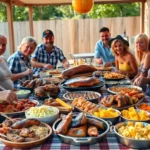We’ve all been there – you’re ready to fire up the grill for that perfect weekend barbecue when suddenly dark clouds roll in. Don’t let unpredictable weather ruin your outdoor cooking plans! Creating a dedicated BBQ shelter transforms your grilling experience from a hit-or-miss adventure into a year-round culinary haven.
A well-designed grill area shelter doesn’t just protect you from rain and harsh sun – it becomes the heart of your outdoor entertainment space. Whether you’re dreaming of a simple canopy setup or a fully enclosed outdoor kitchen, the right shelter maximizes your grilling potential while adding serious value to your property.
We’ll explore innovative BBQ shelter ideas that fit every budget and backyard size. From DIY-friendly options to premium structures, you’ll discover how to create the perfect protected grilling zone that keeps the party going regardless of what Mother Nature throws your way.
Build a Classic Gazebo for Your BBQ Shelter Ideas Grill Area
Classic gazebos offer the perfect combination of elegance and functionality for your outdoor grilling space. These permanent structures create a sophisticated focal point while providing comprehensive weather protection for year-round barbecuing.
Traditional Wooden Gazebo Design
Wooden gazebos bring timeless charm to any backyard grilling setup. Cedar and redwood materials resist weather damage naturally, requiring minimal maintenance while aging beautifully over time. We recommend choosing pressure-treated lumber for the foundation posts to ensure long-lasting stability in various soil conditions.
Design your wooden gazebo with an 8×8 or 10×10 footprint to accommodate standard grill sizes plus prep space. Incorporate built-in benches along two sides for convenient seating during cooking sessions. Add decorative lattice panels between posts to create visual interest while maintaining airflow around your grill area.
Consider installing adjustable louvers in the roof design to control ventilation and smoke dispersal. This feature becomes particularly valuable when grilling fatty meats or using wood chips for smoking. Position electrical outlets at strategic points to power lights, fans, or small appliances during evening cookouts.
Modern Metal Frame Gazebo Options
Steel and aluminum gazebos deliver contemporary style with superior durability for high-use grilling areas. Powder-coated finishes resist rust and fading, maintaining their appearance through multiple seasons of outdoor cooking. These materials handle extreme temperatures better than wood, making them ideal for regions with harsh weather patterns.
Choose rectangular metal gazebos measuring 10×12 or 12×14 feet to create generous workspace around large gas grills or smoker setups. Integrated hooks and shelving systems maximize storage efficiency for grilling tools, seasonings, and cookware. Many modern designs feature retractable canopy sections that adjust based on weather conditions.
Install LED strip lighting around the perimeter for enhanced visibility during nighttime grilling sessions. Metal frames easily support heavier accessories like ceiling fans, speakers, or even small refrigeration units. Consider models with removable side panels that transform your gazebo from an open-air pavilion to a more enclosed cooking space when needed.
Create a Pergola-Style BBQ Shelter for Open-Air Grilling
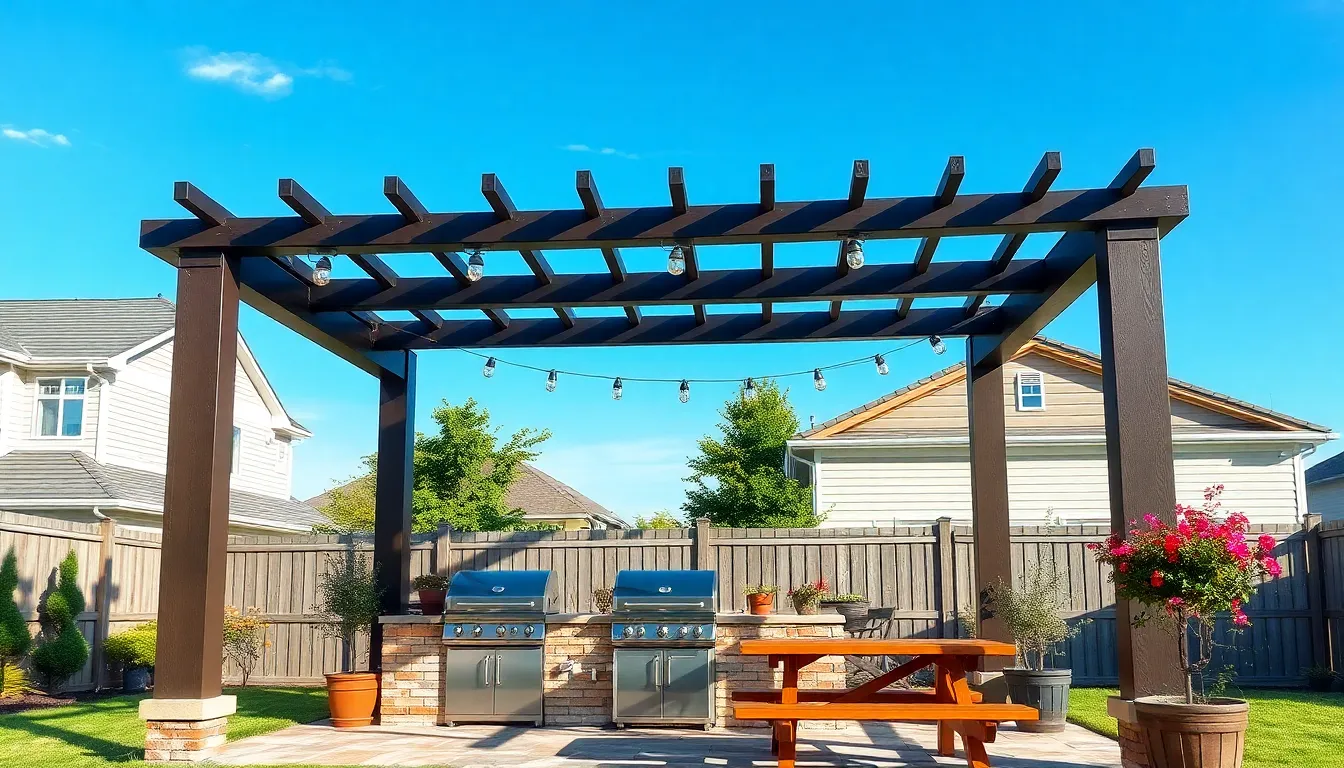
Moving from traditional gazebos to more versatile options, pergolas offer the perfect balance between protection and openness for your grill area. These elegant structures define your BBQ space while maintaining excellent ventilation that keeps smoke flowing freely away from your cooking area.
Vinyl Pergola Installation Tips
Vinyl pergolas deliver low maintenance benefits that make them ideal for busy homeowners who want beautiful BBQ shelters without constant upkeep. Installation begins with securing pergola posts to concrete slabs or pavers using proper anchoring techniques that ensure stability against wind and weather conditions.
Key Installation Steps:
| Step | Process | Requirements |
|---|---|---|
| 1 | Foundation prep | Concrete slabs or pavers |
| 2 | Post anchoring | Weather-resistant fasteners |
| 3 | Panel installation | Proper sealing techniques |
| 4 | Joint sealing | Manufacturer-approved sealants |
Following manufacturer instructions closely prevents water infiltration issues that can compromise your shelter’s integrity over time. Vinyl panels or slats work excellently for roof sections and side screens, providing shade and light rain protection for your grilling activities.
Cleaning your vinyl pergola requires only occasional washing with mild soap and water, making maintenance significantly easier compared to wood alternatives. The smooth vinyl surface resists staining and weathering, ensuring your BBQ shelter maintains its appearance for years without refinishing.
Natural Wood Pergola Construction
Natural wood pergolas bring warmth and rustic appeal that many homeowners prefer over synthetic materials for their outdoor cooking spaces. Cedar and redwood stand out as top choices because they naturally resist rot and insect damage, reducing long term maintenance concerns.
Construction starts with treating or staining the wood to protect against weather damage and harmful UV exposure that can cause cracking and fading. Posts require concrete footings for maximum durability, especially in areas with strong winds or seasonal weather changes.
Wood Pergola Design Options:
- Simple open lattice roofs for basic sun protection
- Complex panel roofs offering enhanced weather shelter
- Integrated hanging systems for lighting and fans
- Customizable curtain attachments for privacy
Flexibility becomes a major advantage with wood pergolas since you can easily hang lighting, ceiling fans, or outdoor curtains to enhance your BBQ grilling experience. Regular maintenance including resealing and damage inspection helps prolong your pergola’s lifespan and keeps it looking attractive.
Adding panel roofs to either vinyl or wood pergolas expands usability by protecting from rain and harsh sun, making your outdoor grilling comfortable throughout different seasons. Polycarbonate or insulated panels control light and temperature effectively, transforming your BBQ area into a year round entertainment space.
Install a Pavilion Structure for Large Grill Area Coverage
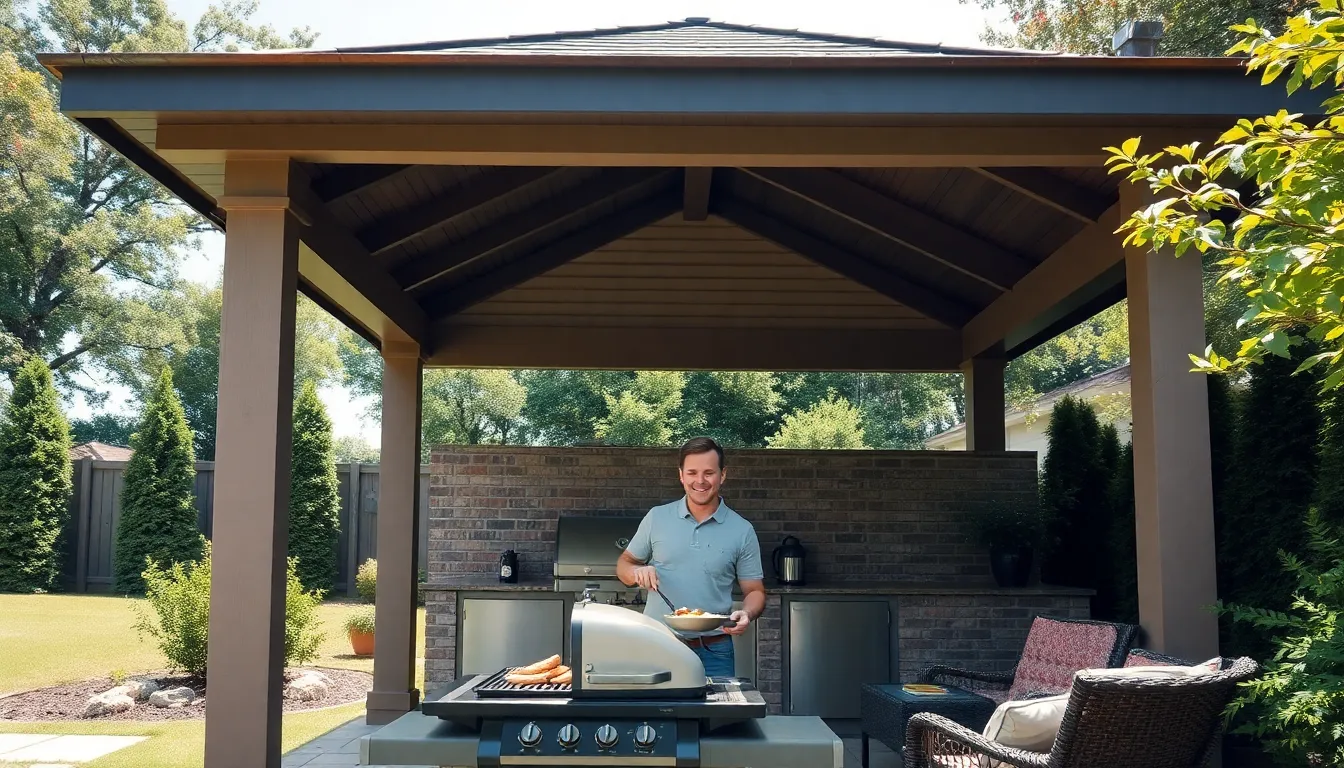
Pavilions offer the most comprehensive coverage for large grill areas, creating a sturdy focal point that unites your entire outdoor cooking space. These attractive structures provide excellent protection from both sun and rain while serving as the centerpiece of your backyard entertainment area.
Permanent Pavilion Features
Permanent pavilions deliver exceptional durability through materials like pressure-treated wood or powder-coated metal that withstand years of outdoor exposure. Most designs feature hard roofing made from metal panels or cedar shingles that provide complete weather protection unlike fabric alternatives.
Built-in counters and shelves on either side of the grill create functional preparation and serving areas that transform your pavilion into a complete outdoor kitchen. We recommend incorporating electrical outlets for appliances, integrated lighting systems like small chandeliers or solar lights, and storage compartments for grilling tools and supplies.
Design flexibility allows permanent pavilions to blend seamlessly with existing landscaping through features like post-mounted hanging plant brackets or vine supports. These structures can accommodate various amenities including ceiling fans for ventilation, built-in beverage stations, and even outdoor televisions for entertainment while cooking.
| Feature | Benefit | Installation Consideration |
|---|---|---|
| Hard roof materials | Complete weather protection | Requires professional installation for metal/cedar |
| Built-in counters | Organized food prep space | Plan electrical and plumbing needs early |
| Integrated lighting | Extended evening use | Consider solar options to reduce wiring costs |
| Post plant supports | Natural aesthetic integration | Choose climbing plants suitable for your climate |
Portable Pavilion Answers
Portable pavilions provide grilling shelter without permanent construction commitments, making them ideal for renters or those wanting seasonal flexibility. These gazebo-style structures can be assembled and disassembled as needed, offering temporary protection during grilling sessions.
Setup requires minimal tools and typically takes 2-4 hours with two people, depending on the size and complexity of the design. Most portable options feature lightweight aluminum frames with weather-resistant fabric canopies that resist fading and water penetration.
Storage becomes simple during off-seasons since these structures break down into compact components that fit in garages or storage sheds. We suggest choosing models with reinforced corner brackets and guy-line attachments for added stability during windy conditions.
Weight considerations matter for portability, with most quality units ranging from 40-80 pounds total, allowing for reasonable transportation between locations or seasonal storage needs.
Design a Lean-To Shelter Against Your Home’s Exterior
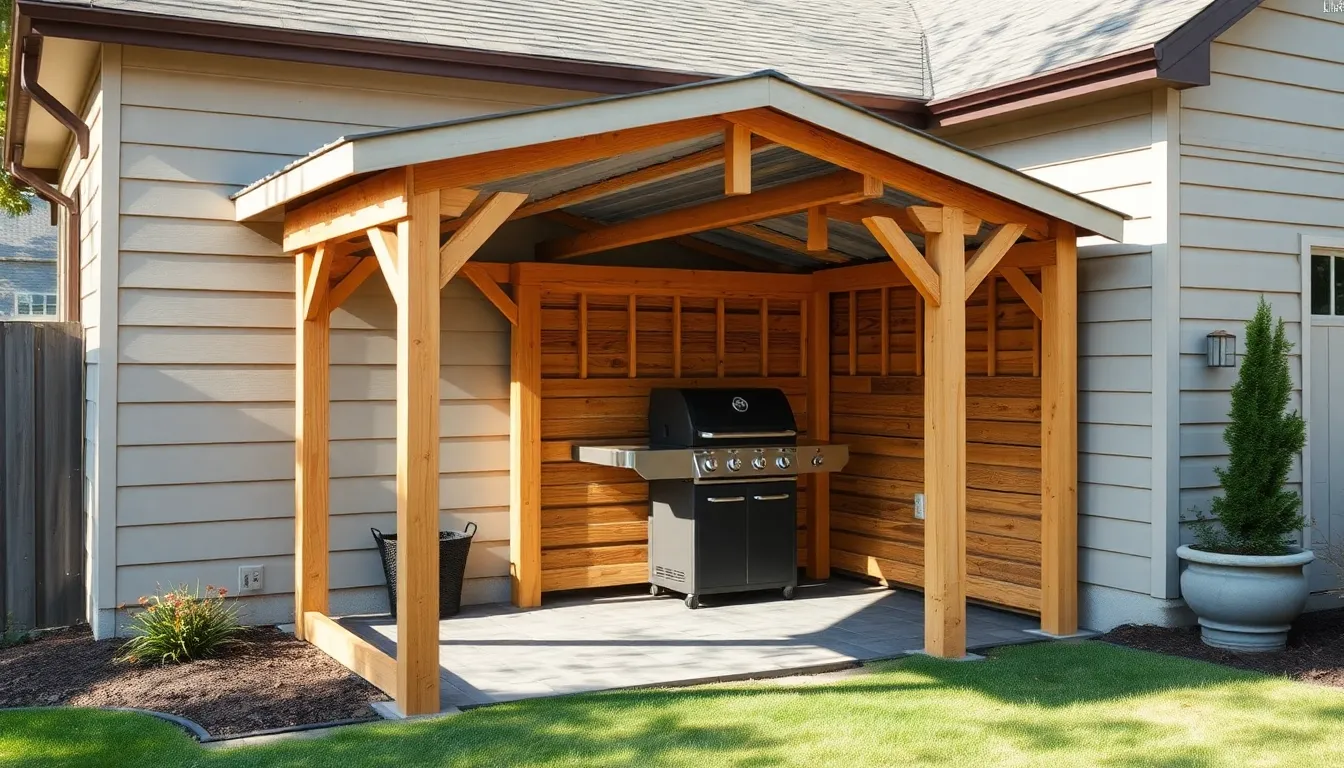
We’ve found that lean-to shelters offer one of the most practical and cost-effective approaches to creating a protected grill area. Building against your home’s exterior wall reduces material costs while maximizing structural support and weather protection.
Attachment Methods for House Lean-Tos
Secure ledger boards directly to your home’s exterior wall studs using galvanized bolts or heavy-duty screws rated for outdoor use. We recommend installing flashing tape behind the ledger board to create a waterproof seal where the shelter meets your house.
Position the top plate of your lean-to frame against the exterior wall at the appropriate height to achieve proper roof pitch. Most successful installations use a 4:12 pitch ratio for optimal water drainage and snow load management.
Use pressure-treated lumber for all structural components that contact your home’s exterior wall. This prevents moisture damage and extends the lifespan of your BBQ shelter significantly.
Install proper anchoring into wall studs rather than just siding material to ensure your shelter can withstand wind loads. We suggest using structural screws or through-bolts that penetrate at least 2.5 inches into solid framing.
Apply construction adhesive between the ledger board and house wall before securing with fasteners for additional weather sealing. This creates a secondary moisture barrier that prevents water infiltration.
Weatherproofing Considerations
Install sloped roofing with adequate pitch to direct water away from both your grill area and home exterior. Metal roofing panels work exceptionally well for lean-to designs due to their lightweight properties and superior water shedding capabilities.
Apply weatherproof stains or exterior-grade paints to all exposed wood surfaces before installation. We’ve observed that pre-treating lumber significantly reduces maintenance requirements over time.
Include gutters along the lower edge of your lean-to roof to channel rainwater away from the foundation and prevent pooling around your grill area. This also protects your home’s siding from water damage.
Maintain proper ventilation by leaving gaps between the shelter roof and your house wall or installing ridge vents. Adequate airflow prevents smoke buildup and reduces heat accumulation around your grill.
Seal all connections where your lean-to meets the house using high-quality exterior caulk rated for temperature fluctuations. Regular inspection and resealing every 2-3 years ensures continued weatherproofing effectiveness.
Construct a Simple Canopy Setup for Budget-Friendly Protection

Budget-conscious grillers can create effective protection without very costly through simple canopy installations. These straightforward answers offer immediate shelter while maintaining the flexibility to adapt your outdoor cooking space as needed.
Retractable Canopy Systems
Retractable canopies deliver the perfect balance of weather protection and operational flexibility for our grilling areas. We can extend these systems during cooking sessions and retract them completely when the weather clears or storage becomes necessary.
Manual operation provides reliable control through hand-crank mechanisms that extend and retract the fabric cover along metal tracks. These systems typically cost between $200-600 depending on size and fabric quality.
Motorized versions offer push-button convenience with electric motors that deploy the canopy in under 30 seconds. While the initial investment ranges from $800-1,500, we gain effortless operation that encourages regular use.
Mounting options include wall-mounted brackets that attach directly to our home’s exterior or freestanding posts that create independent shelter zones. Wall-mounted systems require structural support capable of handling wind loads up to 25 mph.
Fabric selection matters significantly for durability and performance. Solution-dyed acrylic fabrics resist fading and water penetration while polyester options provide budget-friendly alternatives with decent weather resistance.
Fixed Canopy Installation
Fixed canopy structures transform our grill areas into permanent outdoor rooms with consistent weather protection. These installations require more upfront planning but deliver long-term value through enhanced functionality and property appeal.
Pergola installations combine partial shade with excellent ventilation using slatted roof designs that allow heat and smoke to escape naturally. Cedar and pressure-treated lumber pergolas cost $1,200-3,000 for materials while metal versions range from $800-2,500.
Solid roof canopies provide complete weather protection using materials like corrugated metal, polycarbonate panels, or architectural shingles. These installations require proper structural support with posts rated for local wind and snow loads.
Foundation requirements vary based on canopy size and local building codes. Concrete footings extending below the frost line ensure stability while adjustable post brackets allow for minor leveling adjustments during installation.
Integrated features maximize our investment through built-in storage cabinets, electrical conduits for lighting, and counter spaces that expand our outdoor cooking capabilities. Professional installation ensures proper permits and structural compliance with local regulations.
Build a Three-Season Room Extension for Year-Round BBQ Use
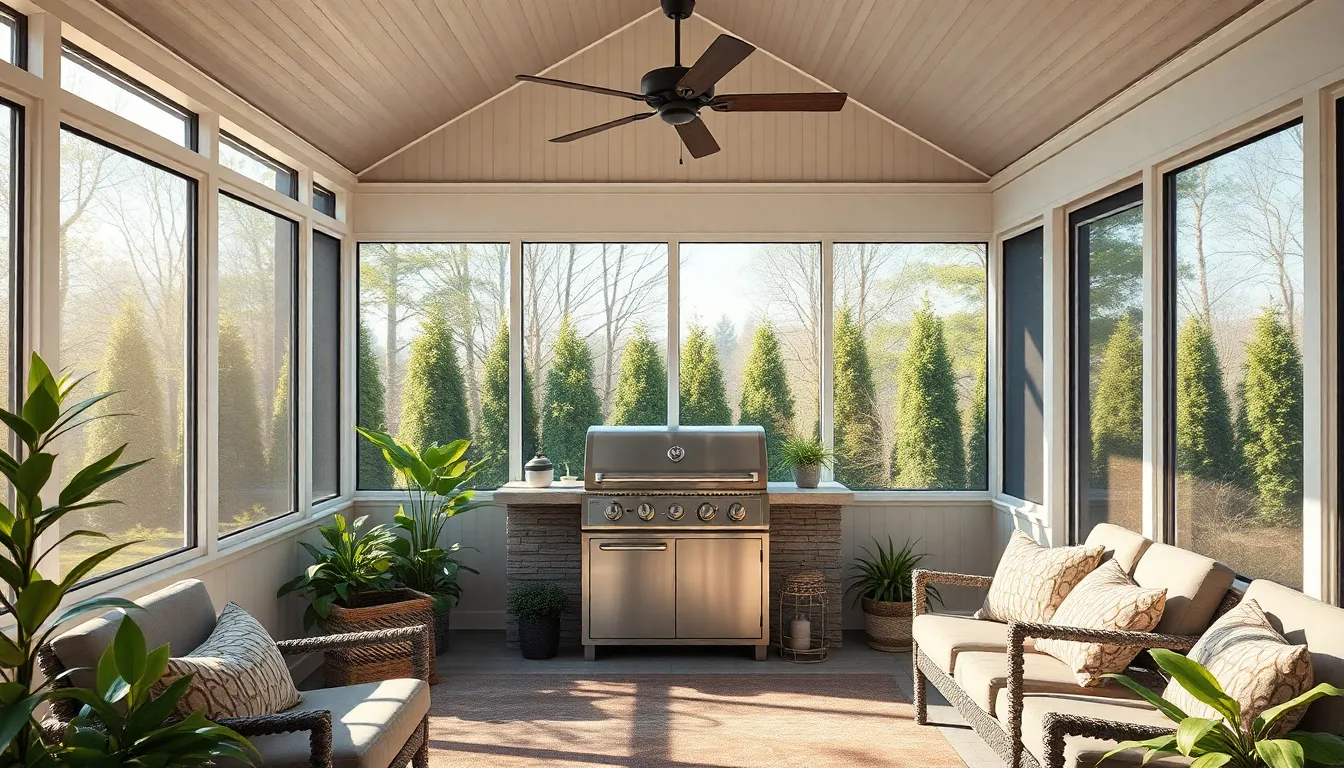
Three-season rooms represent the perfect evolution from basic canopy protection to a semi-enclosed grilling sanctuary. We’ve found these extensions dramatically expand your BBQ season by combining indoor comfort with outdoor accessibility.
Screened Room Options
Screened walls protect against insects and debris without fully enclosing your grilling space, maintaining the crucial airflow needed to prevent smoke buildup. Modern screened room designs feature aluminum or wood framing systems that support fine mesh screens while allowing natural ventilation to flow freely through your cooking area.
Ceiling fans enhance comfort and ventilation in screened BBQ rooms, creating additional air circulation that helps disperse grilling smoke and reduces heat accumulation during summer cooking sessions. We recommend installing outdoor-rated ceiling fans with variable speed controls to adjust airflow based on weather conditions and cooking intensity.
Sliding or removable screen systems adapt to different weather conditions throughout the grilling season. These flexible designs allow you to fully open sections during pleasant weather while maintaining insect protection when needed, giving you complete control over your outdoor cooking environment.
Natural light and outdoor views remain unobstructed in well-designed screened rooms, preserving the open-air grilling experience while providing essential weather protection. Large screened openings create an airy atmosphere that connects your cooking space with the surrounding industry.
Climate Control Features
Outdoor-rated electric or propane heaters extend your BBQ season into colder months by providing targeted warmth in your three-season room. We’ve observed that strategically placed heating elements can maintain comfortable temperatures even when outdoor conditions would typically end the grilling season.
Proper ventilation systems disperse smoke and prevent dangerous heat buildup in enclosed grilling areas. Essential ventilation features include ceiling fans, vent hoods, and adjustable windows or screens that create controlled airflow patterns throughout your cooking space.
Insulated roofing materials protect against rain, wind, and cold while maintaining structural integrity during harsh weather conditions. Quality roofing systems combined with weatherproof materials enable extended outdoor cooking seasons by creating a stable microclimate within your BBQ shelter.
Flexible window and screen systems help regulate temperature and airflow based on seasonal changes and cooking requirements. These adaptable features allow you to customize your grilling environment, whether you need maximum ventilation during hot summer sessions or weather protection during cooler months.
Add a Kitchen Island Hood for Integrated Grill Shelter Ideas
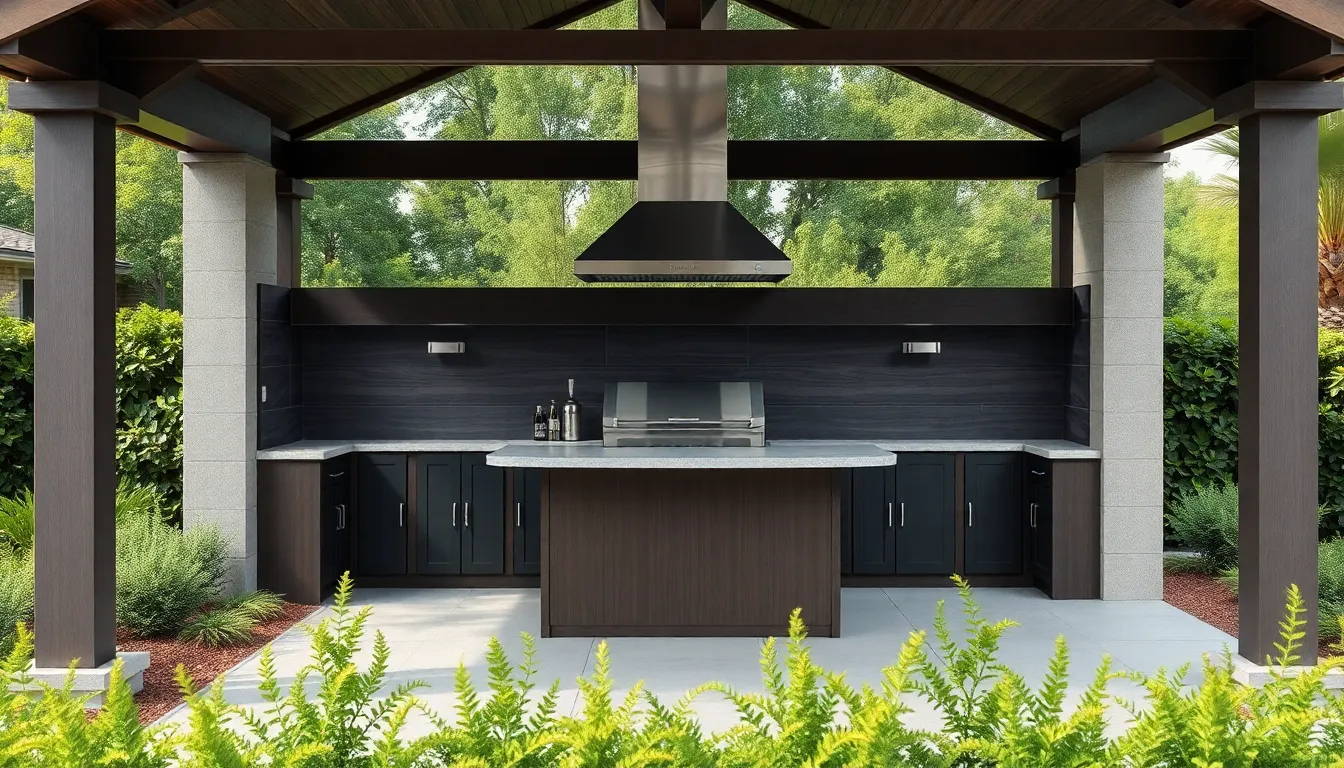
Installing a kitchen island hood transforms your BBQ shelter into a sophisticated outdoor cooking space. We recommend extending the hood at least 6 inches wider than your grill to effectively capture smoke and hot air.
Outdoor Kitchen Integration
Combining your grill with complementary elements creates a cohesive outdoor kitchen setup. Countertops, storage answers, and kitchen islands work together to form a functional cooking and entertaining space within your shelter.
Adequate ventilation becomes crucial when integrating multiple cooking elements. We install vent panels on opposite sides of kitchen islands, typically requiring about 20 square inches on each side to allow hot air and potential gas leaks to escape safely.
Material selection plays a vital role in outdoor kitchen integration. Choose weather-resistant materials designed for outdoor conditions, and protect combustible materials near grills using insulated jackets to prevent fire hazards.
Island-mounted vent hoods work exceptionally well for centrally located grills within your BBQ shelter design. These specialized outdoor range hoods prevent smoke buildup while improving air quality throughout your cooking area.
Ventilation Requirements
Ventilation capacity depends directly on your grill’s BTU rating and fuel type. Calculate 1 CFM (cubic feet per minute) for every 100 BTUs, maintaining a minimum of 1,200 CFM ventilation to handle smoke and heat properly.
Fuel type determines optimal vent panel placement within your shelter. Position vent panels low on island walls when using propane (heavier than air) and higher when using natural gas (lighter than air).
Enclosed structures with poor cross-ventilation require mandatory vent hood installation. BBQ shelters with roofs or walls, such as gazebos or pergolas, need powerful exhaust systems to draw smoke and heat away efficiently.
Grease-catching baffle filters enhance both safety and maintenance in your outdoor kitchen hood system. These components control smoke particles while making cleanup easier after cooking sessions.
Local building codes often dictate exact ventilation requirements for outdoor cooking areas. Check regulations in your area to ensure compliance with safety standards for your integrated grill shelter design.
Install Shade Sails for Modern BBQ Shelter Coverage
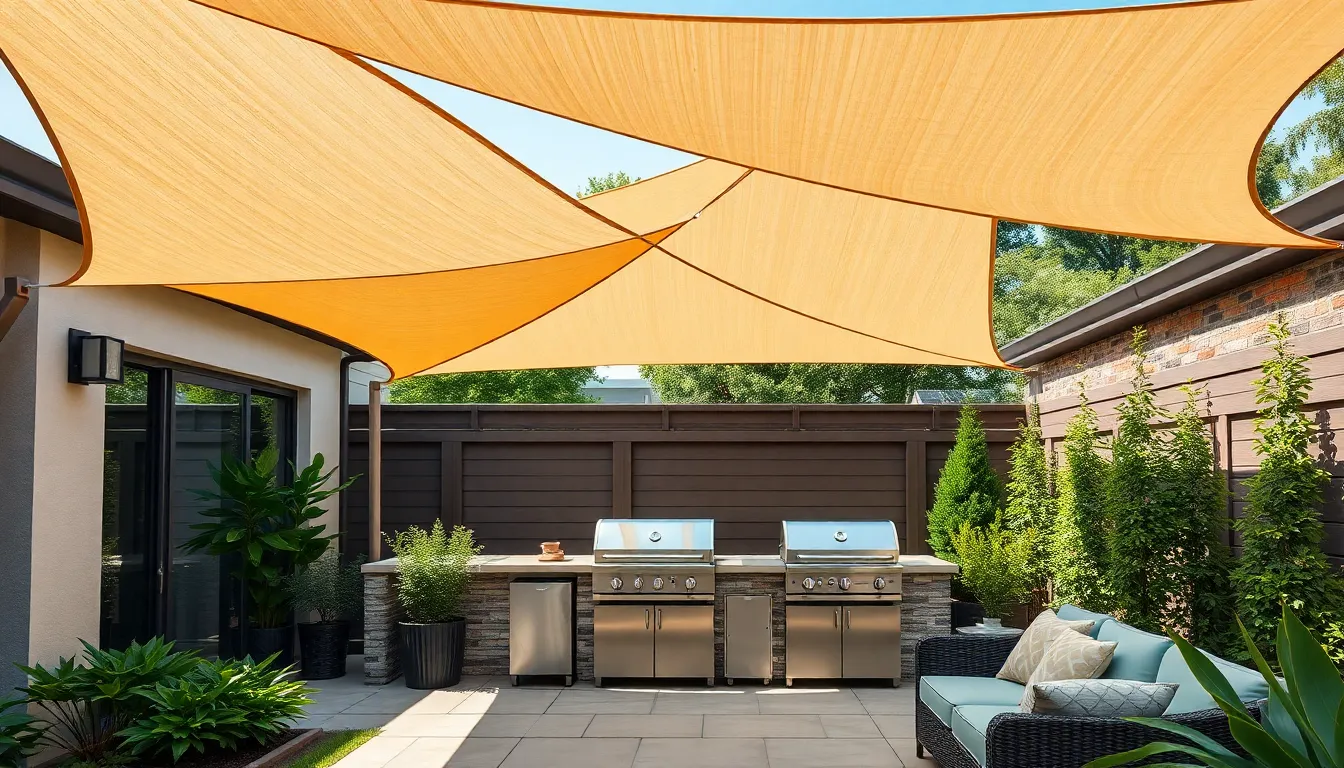
Shade sails represent the perfect evolution from traditional BBQ shelters, offering contemporary style with exceptional functionality for modern outdoor cooking spaces. These weather-resistant fabric canopies stretch elegantly between anchor points, creating sophisticated protection that complements any backyard design while maintaining the open-air grilling experience we love.
Triangular Shade Sail Configurations
Triangular shade sails dominate the modern BBQ shelter market because they offer unmatched versatility in covering different grill and seating layouts effectively. We can overlap multiple triangular sails to create ever-changing patterns that provide varying levels of shade and light throughout our outdoor cooking area.
Anchoring options give us incredible flexibility when designing our BBQ shelter coverage. Posts, existing trees, or parts of our home’s structure can serve as mounting points, allowing us to customize the sail configuration to match our exact outdoor space and grilling setup perfectly.
Airflow circulation becomes a natural benefit with triangular configurations since the angled surfaces help proper ventilation around our grill area. This prevents dangerous heat buildup while maintaining comfortable cooking conditions even during extended BBQ sessions.
Creative combinations of triangular sails let us expand coverage as our outdoor entertaining needs grow. We can start with a single sail over our grill and gradually add complementary triangles to cover dining areas, prep spaces, or seating zones without compromising the modern aesthetic.
Maintenance and Durability Tips
Regular tension checks ensure our shade sails maintain their elegant appearance and structural integrity throughout the grilling season. We should inspect anchor points monthly and adjust tension as needed to prevent sagging or excessive stress on mounting hardware.
Cleaning protocols using mild soap and water help preserve the fabric’s UV protection and waterproof properties without causing damage. We must avoid harsh chemicals or pressure washing, which can compromise the sail’s weather resistance and reduce its lifespan significantly.
Weather protection strategies become crucial during harsh conditions like storms or heavy snowfall. We should remove or loosen our sails temporarily to prevent tearing, then reinstall them once conditions improve for continued BBQ shelter coverage.
Fabric selection impacts long term durability, so we recommend investing in UV stabilized and waterproof materials designed specifically for outdoor use. Quality hardware with rust resistant coatings will extend our shade sail system’s lifespan and maintain reliable performance across multiple grilling seasons.
Incorporate Natural Elements with Living Roof Shelters
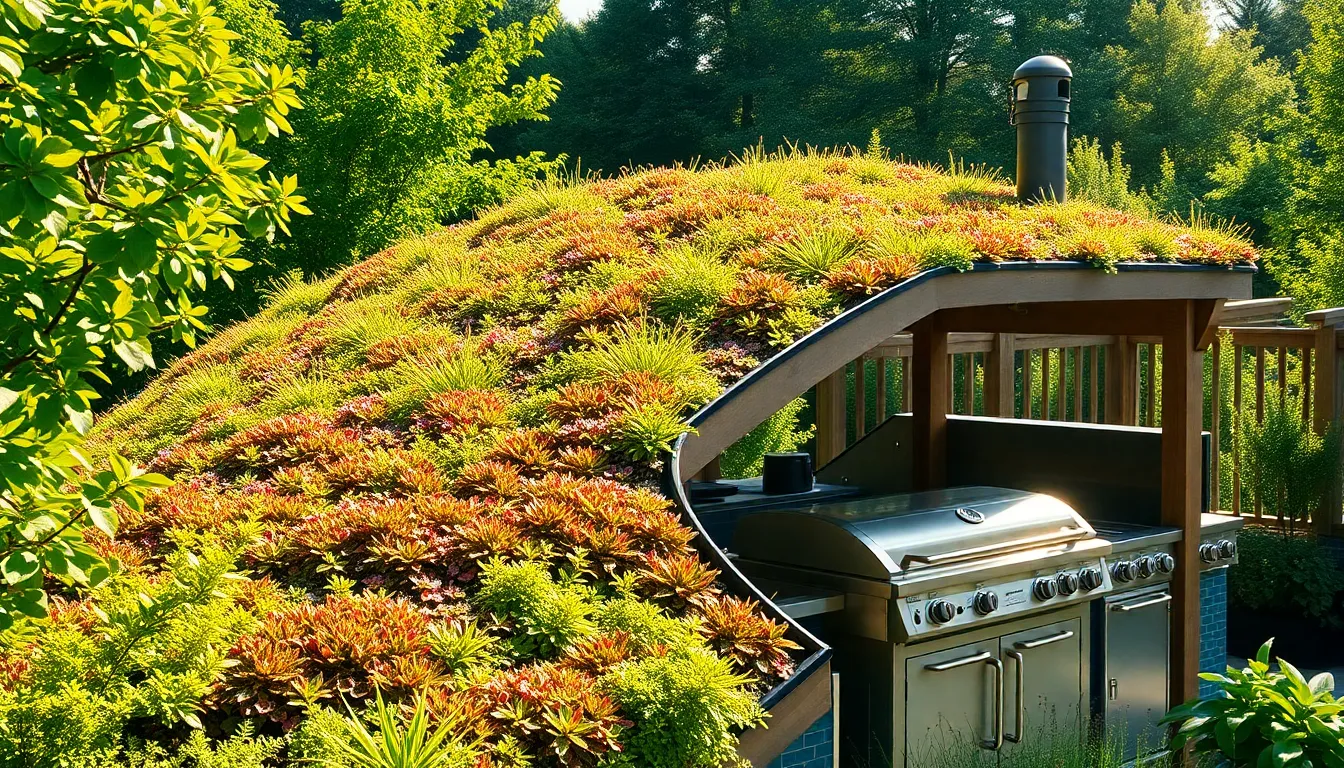
Living roof shelters bring nature directly into your BBQ area, creating an eco-friendly grilling space that blends seamlessly with your industry. We’ll explore how these green roof systems transform ordinary shelters into sustainable outdoor cooking havens.
Green Roof Construction
Building a living roof for your BBQ shelter requires multiple protective layers that work together to support plant life while safeguarding the structure underneath. We start with a waterproof membrane as the foundation layer, protecting your shelter from moisture damage that could compromise its integrity over time.
Installing a root barrier comes next, preventing plant roots from penetrating and damaging the waterproof membrane below. This crucial layer ensures your green roof system remains watertight throughout its lifespan.
Adding a drainage layer allows excess water to flow away from the growing medium, preventing waterlogged conditions that could harm both plants and structure. We recommend using lightweight drainage materials specifically designed for rooftop applications.
Creating the growing medium involves using specialized soil substitutes that provide nutrients while remaining light enough for rooftop installation. These lightweight growing mediums support plant health without adding excessive weight to your shelter structure.
Selecting appropriate vegetation caps off the construction process, requiring plants that thrive in shallow soil conditions and withstand rooftop exposure. Sedums remain the most popular choice due to their exceptional resilience in soilless mediums and minimal maintenance requirements.
Plant Selection for Living Shelters
Choosing drought tolerant plants becomes essential for living roof success, especially given the direct sun exposure and limited water retention typical of rooftop environments. We prioritize species that can survive with minimal irrigation while maintaining their aesthetic appeal throughout the growing season.
Selecting low growth height varieties prevents interference with your BBQ shelter’s functionality, ensuring plants don’t obstruct ventilation or create fire hazards near your grill area. These compact plants provide visual interest without compromising safety or usability.
Incorporating native plants supports local biodiversity while reducing maintenance requirements, as these species naturally adapt to your regional climate conditions. Native selections also attract beneficial pollinators, creating a thriving network above your grilling space.
Sedums top our recommended plant list for their exceptional durability and minimal care needs in shallow growing mediums. Succulents offer another excellent option, storing water in their leaves to survive extended dry periods common on rooftops.
Hardy perennials round out the ideal plant palette, returning year after year with minimal intervention while providing seasonal interest through changing foliage and blooms. These plants help with rainwater filtration, habitat creation for pollinators, and temperature regulation around your grill area.
Design Multi-Functional Shelter Spaces for Entertainment
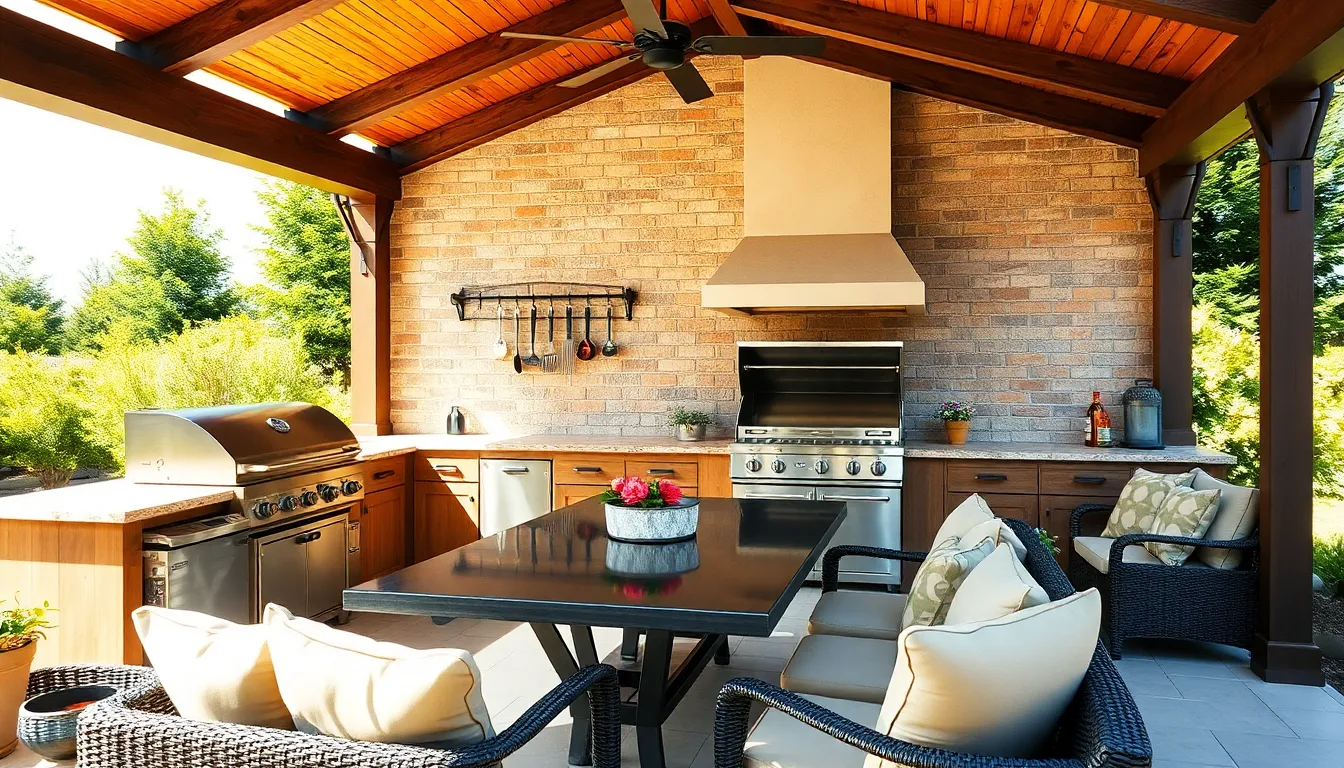
We’ve covered various shelter structures, but now it’s time to maximize their potential by creating truly functional entertainment spaces. Transforming your BBQ shelter into a multi-purpose hub requires thoughtful integration of storage answers and comfortable areas for dining and socializing.
Storage Integration Ideas
Countertops and cabinets create the foundation of an organized outdoor kitchen by providing essential workspace around your grill area. Built-in storage cabinets underneath these counters keep utensils, charcoal, and condiments within easy reach while maintaining a clean, organized appearance. Professional outdoor kitchen designs often incorporate weatherproof cabinetry that protects supplies from rain and humidity while blending seamlessly with your shelter’s aesthetic.
Hooks and shelving systems maximize vertical space in smaller shelters by providing dedicated spots for grilling tools and accessories. Installing stainless steel hooks along shelter walls keeps tongs, spatulas, and brushes organized and easily accessible during cooking sessions. Open shelving near the grill accommodates spice racks, cutting boards, and serving plates that you’ll use frequently throughout your outdoor cooking experience.
Multi-purpose storage answers combine functionality with weather protection through strategically placed cabinetry and compartments. Weatherproof storage benches serve dual purposes by providing seating while concealing propane tanks, charcoal bags, and seasonal grilling supplies. Custom-built storage units can incorporate wine fridges, ice bins, and pull-out drawers that transform your shelter into a comprehensive outdoor entertaining center.
Seating and Dining Areas
Comfortable seating arrangements enhance the social aspect of outdoor grilling by creating inviting spaces for family and guests to gather. Built-in benches along shelter perimeters provide permanent seating that doesn’t require seasonal storage, while movable chairs and outdoor sofas offer flexibility for different group sizes. Cushioned seating with weather-resistant fabrics ensures comfort during extended grilling sessions and outdoor gatherings.
Dining tables positioned strategically near your grill shelter help easy serving and create natural gathering spots for meals. Permanent dining tables built into the shelter design provide stability and eliminate setup time, while expandable outdoor tables accommodate varying numbers of guests throughout different seasons. Counter-height dining surfaces work particularly well in BBQ shelters because they create casual eating areas that encourage interaction between the cook and diners.
Flexible entertainment spaces adapt to different weather conditions and social situations through adjustable features and modular components. Semi-pergolas with retractable canopies allow you to control shade and protection levels based on current conditions, while removable side panels can transform open shelters into more intimate dining rooms. Elevated platforms or raised decks within your shelter create defined dining zones that enhance the overall ambiance while providing better views of your outdoor space.
Conclusion
Creating the perfect BBQ shelter transforms your outdoor cooking from a weather-dependent activity into a year-round passion. We’ve explored options that fit every budget and backyard size from simple canopies to sophisticated pavilions with integrated kitchen features.
The key lies in choosing a shelter that matches your grilling frequency cooking style and entertainment needs. Whether you opt for a classic gazebo’s elegance a pergola’s open-air charm or a modern shade sail’s versatility each option offers unique benefits that enhance your outdoor experience.
Your BBQ shelter investment pays dividends through extended grilling seasons increased property value and countless memorable gatherings with family and friends. Start planning your ideal grill sanctuary today and discover how the right shelter elevates every outdoor cooking adventure.
Frequently Asked Questions
What is a BBQ shelter and why do I need one?
A BBQ shelter is a protective structure designed to cover your outdoor grilling area. It shields you from rain, sun, and wind while cooking, allowing you to grill year-round regardless of weather conditions. Beyond weather protection, it serves as a central hub for outdoor entertainment and can significantly increase your property value.
What are the most popular types of BBQ shelters?
The most popular BBQ shelter options include gazebos (wooden or metal frame), pergolas (vinyl or wood), pavilions (permanent or portable), lean-to shelters, canopy setups, and three-season room extensions. Each offers different levels of protection, style, and functionality to suit various budgets and backyard sizes.
How much does a BBQ shelter typically cost?
BBQ shelter costs vary widely depending on size, materials, and complexity. Simple canopy setups can cost under $500, while DIY pergolas range from $1,000-3,000. Premium permanent pavilions and three-season rooms can cost $5,000-15,000 or more. Portable options offer budget-friendly alternatives for those seeking temporary solutions.
What’s the difference between a gazebo and a pergola for BBQ use?
Gazebos provide complete overhead coverage with solid roofing, offering full protection from rain and sun. Pergolas feature open slat construction that allows partial sunlight and airflow while providing some shade. Gazebos are better for all-weather protection, while pergolas offer better ventilation for grilling.
Can I install a BBQ shelter myself?
Many BBQ shelters can be DIY projects, especially pergolas, lean-to structures, and portable pavilions. However, permanent structures may require professional installation to ensure proper anchoring, electrical work, and compliance with local building codes. Always check local permits and regulations before beginning construction.
What materials work best for outdoor BBQ shelters?
Weather-resistant materials are essential for BBQ shelters. Pressure-treated lumber, cedar, and redwood offer natural durability for wood structures. Powder-coated metal frames provide excellent longevity. For roofing, consider polycarbonate panels, metal roofing, or weatherproof fabric depending on your protection needs and budget.
How do I maintain my BBQ shelter?
Regular maintenance includes cleaning debris, checking for loose fasteners, applying weatherproof stains annually for wood structures, and inspecting roofing materials for damage. Metal structures need occasional rust prevention treatment. Proper ventilation and drainage help prevent moisture damage and extend shelter lifespan.
Do I need permits for a BBQ shelter?
Permit requirements vary by location and structure size. Permanent structures, electrical installations, and shelters over certain dimensions typically require permits. Temporary or portable shelters usually don’t need permits. Always check with your local building department before installation to ensure compliance with regulations.
Can BBQ shelters be used year-round?
Yes, many BBQ shelters can be used year-round with proper design features. Three-season rooms with heating elements, enclosed structures, and weatherproofing allow for cold-weather grilling. Proper ventilation, insulation, and climate control features extend usability throughout different seasons and weather conditions.
What features should I consider when choosing a BBQ shelter?
Key features to consider include weather protection level, ventilation systems, storage solutions, lighting options, electrical access, size and capacity, material durability, maintenance requirements, and integration with existing landscaping. Also consider whether you need permanent or portable options based on your living situation.







